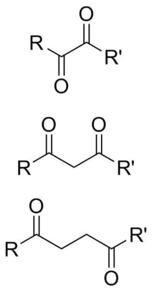Dicarbonyl

In
1,2-Dicarbonyls
1,2-Dialdehyde
The only 1,2-dialdehyde is glyoxal, (CHO)2. Like many alkyldialdehydes, glyoxal is encountered almost exclusively as its hydrate and oligomers thereof. These derivatives often behave equivalently to the aldehydes since hydration is reversible. Glyoxal condenses readily with amines. Via such reactions, it is a precursor to many heterocycles, e.g. imidazoles.

1,2-Diketones
The principal diketone is diacetyl, also known as 2,3-butanedione, CH3C(O)C(O)CH3. 1,2-Diketones are often generated by oxidation (dehydrogenation) of the diols:[1]
2,3-Butanedione,
A distinctive feature of 1,2-diketones is the long C-C bond linking the carbonyl groups. This bond distance is about 1.54 Å, compared to 1.45 Å for the corresponding bond in
1,2-Diketones condense with many bifunctional nucleophiles, such as urea and thiourea to give heterocycles. Condensation with aromatic amines gives diketimine ((RC=NAr)2).
In the cases of 1,2-cyclohexanedione and 1,2-cyclopentanedione, the enol is about 1-3 kcal/mol more stable than the diketo form.[3]
1,2-Ketoaldehydes

A well-known compound of this class is methylglyoxal, CH3C(O)CHO, also known as pyruvaldehyde. These compounds are also known as 2-oxoaldehydes[4] or α-ketoaldehydes.
1,2-Diesters and diacids
Oxalic acid and its esters define this family of compounds. The diacid is produced industrially by oxidation of waste sugars. It occurs naturally (as the conjugate base), notably in members of the plant species Oxalis. Condensation of the diesters with diamines gives cyclic diamides.
α-Keto- and formylcarboxylic acids

α-Keto-acids and -esters are well known.
1,3-Dicarbonyls
1,3-Dialdehydes
The parent 1,3-dialdehyde is malondialdehyde (CH2(CHO)2), a β-dicarbonyl. Like most dialdehydes, it is rarely encountered as such. Instead it is handled almost exclusively as its hydrate, methyl acetal, and oligomers thereof. These derivatives often behave like the parent. Many 2-substituted derivatives are known. They are often prepared by alkylation of the enolate of malondialdehyde.
1,3-Diketones
1,3-Diketones are also called β-diketones. An important member is acetylacetone, CH3C(O)CH2C(O)CH3. Dimedone is a cyclic 1,3-diketone. 1,3-Indandione is the cyclic 1,3-diketone fused to a benzene ring. Acetylacetone is prepared industrially by the thermal rearrangement of isopropenylacetate.[1] Another cyclic 1,3-diketone is 2,2,4,4-tetramethylcyclobutanedione, which is a precursor to a useful diol.
1,3-Diketones often tautomerize to an enol and ketol. They usually exist predominantly in the enol form [citation needed]. The percent enol in acetylacetone, trifluoroacetylacetone, and hexafluoroacetylacetone are 85, 97, and 100%, respectively (neat, 33 °C).[5] Cyclic 1,3-diketones, such as 1,3-cyclohexanedione and dimedone, similarly exist significantly in the enol form.
Like other diketones, 1,3-diketones are versatile precursors to heterocycles. The conjugate base derived from 1,3-ketones can serve as ligand s to form metal acetylacetonate coordination complexes. In the DeMayo reaction 1,3-diketones react with alkenes in a photochemical pericyclic reaction to form (substituted) 1,5-diketones.
Classically, 1,3-diketones are prepared by the Claisen condensation of a ketone with an ester.
1,3-Diesters and diacids
Malonic acid and its esters are the parent members of this class of dicarbonyls. Also common are the 2-substituted derivatives with the formula RCH(CO2R)2, which arise by C-alkylation of the conjugate base (the enolate) NaCH(CO2R)2.
β-Keto-esters
β-Keto-esters arise readily by the condensation of a pair of esters. A well known example is ethyl acetoacetate (although it is prepared by ethanolysis of ketene).
1,4-Dicarbonyls
1,4-Dialdehydes
Succinaldehyde (CH2CHO)2 is the simplest and parent 1,4-dialdehyde. The aromatic derivative is phthalaldehyde.
1,4-Diketones

Diketones with two methylene groups separating the carbonyl groups, also called γ-diketones, typically coexist with their
This reactivity is the basis of the neurotoxicity of γ-diketones.[6] 1,4-Diketones are also precursor to furans and thiophenes. The condensation of 1,4-diketones (and related substrates) with hydrazines afford dihydropyridazines, which can be converted to pyridazines.
1,4-Diesters and diacids
Succinic acid and its esters are the parent members of this family of 1,4-dicarbonyls. Succinic acid is notable as a component in the citric acid cycle. It forms a cyclic acid anhydride, succinic anhydride. Unsaturated members include maleic and fumaric acids and their esters.
1,5-Dicarbonyls
1,5-Dialdehydes
Glutaraldehyde (CH2)3(CHO)2 is the simplest and parent 1,5-dialdehyde. It hydrates readily. The aromatic analogue is isophthalaldehyde.[7]
1,5-Diketones
These diketones have three methylene groups separating the carbonyl groups.
1,5-Diesters and diacids
Glutaric acid (CH2)3(CO2H)2 is the parent 1,5-diacid.
Hydration and cyclization

Small aldehydes tend to hydrate. Hydration is prevalent for dialdehydes. Glyoxal forms a series of cyclic hydrates. Succinaldehyde hydrates readily to give 2,5-dihydroxytetrahydrofuran. The aromatic phthalaldehyde also forms hydrated.

Similar hydration and cyclization equilibria apply to maleic dialdehyde,[8][9] glutaraldehyde, and adipaldehyde.
Safety
A number of dicarbonyl compounds are bioactive. Diacetyl is known to cause the lung disease
See also
References
- ^ ISBN 978-3527306732.
- .
- PMID 31458971.
- ^ "CHEBI:27659 - 2-oxo aldehyde". Chemical Entities of Biological Interest (ChEBI).
- .
- ^ Stephen R Clough; Leyna Mulholland (2005), "Hexane", Encyclopedia of Toxicology, vol. 2 (2nd ed.), Elsevier, pp. 522–525
- .
- .
- .
- PMID 27326900.




